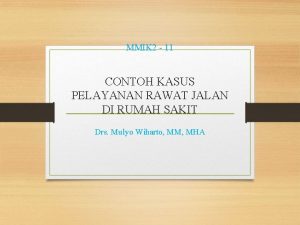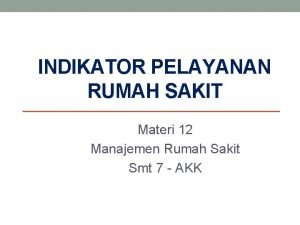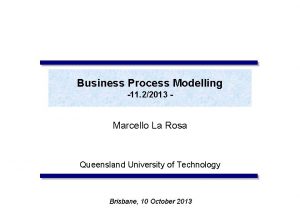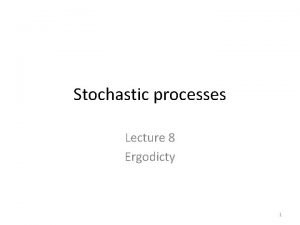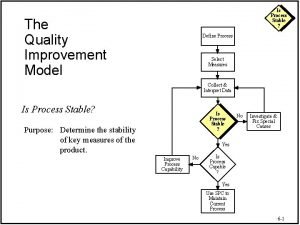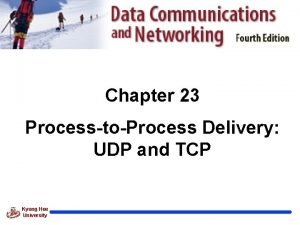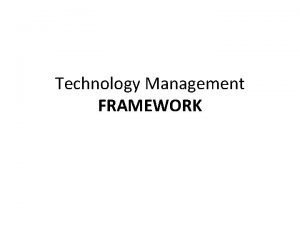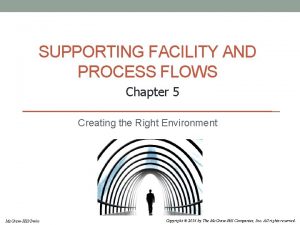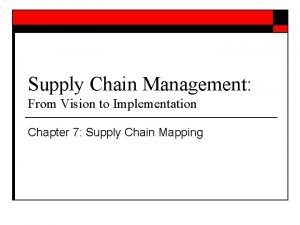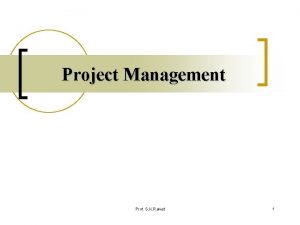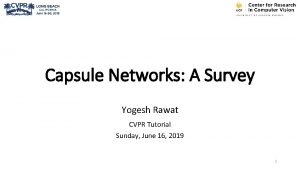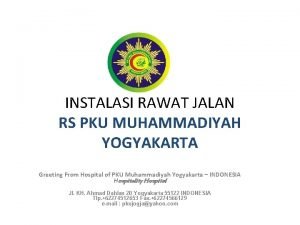MANAGEMENT PROCESS Mr S K Rawat What is



























- Slides: 27

MANAGEMENT PROCESS – Mr. S. K. Rawat

What is Management? Management is, as is too well known, the art of getting things done through others. Stated differently, management is the social and technical process that utilizes resources, influences human actions and facilities changes in order to accomplish an organization's goals. The survival and success of an organization largely depends upon the quality of management. Competent Management will contribute to the success of the organization, but others fail, whatever the constraint is.

Definition George Terry defines “Management is a distinct process consisting of planning, organizing, actuating, and controlling, performed to determine and accomplish stated objectives with the use of human being and other resources. ” Harold Koontz wrote, “ Management is the art of getting things done through and with people in formally organized groups. ” Henri Fayol “To manage is to forecast and to plan, to organize, to command to coordinate and to control. ” Peter Drucker writes, “ Management is a multi-purpose organ that manages a business, manages managers and manages workers and work. ”

Concept of Management The following are the important features of management: 1. 2. 3. 4. 5. 6. 7. 8. Management is a Process. Management is an Art as well as a Science. Management follows Professional Approach. Management is Intangible. Management is Group Activity. Management is Result Oriented. Management follows Established Principles. Management is Dynamic in Nature.

Importance of Management The importance of management are as follows: Facilitates Optimum Utilization of Resources. Generates Efficiency. Motivates Personnel. Encourages Initiative. Develops Team Spirit. Facilitates Innovation. Improves Technology. Maintains Good Relations. Facilitates Growth and Expansion. Assists Society. Reduction of Employees Absenteeism and Turnover. Creates Corporate Image.

Management Level Pyramid Top Managers Middle Managers First-line Managers

Management Level Pyramid President, CEO, VP Top Managers Middle Managers First-line Managers • Make long-range plans • Establish policies • Represent the company

Management Level Pyramid Controller, Marketing Manager, Sales Manager Top Managers Middle Managers First-line Managers • Implement goals • Make decisions • Direct first-line managers

Management Level Pyramid Office Manager, Supervisor, Foreman, Department Head Top Managers Middle Managers First-line Managers • Implement plans • Oversee workers • Assist middle managers

Levels of Management In an organization, all managers do not belong to the same level, just as all students of a college do not belong to the same class. Some managers belong to higher level, level whereas, others belong to the lower level, level and some others belongs to the middle level Normally, management positions are ranked into three broad levels, i. e. (i) Top level (ii) Middle level and (iii) Lower level

Levels of Management…. (continued) 1 TOP 2 MIDDLE 3 LOWER There are three basic managerial skills such as conceptual, human and technical. Managers at all levels carry on the functions of planning, organizing, directing, and controlling.

Levels of Management…. (continued) Point of difference Top Level Designation CEO, GM, VP, MD, President and so on Skills Required Conceptual skills Middle Level Lower Level Divisional Heads, Assistant Department Managers, and so Supervisors, on. Foremen, and so on. More of human skills with some conceptual, and technical skills. Technical skills.

Levels of Management…. (continued) Point of difference Top Level Middle Level Concern for Determination of company goals. Framing of corporate policy. Mobilization of resources. Providing recommendations to top management. Interpretation of policies framed by the top mgt, etc. Responsible to Shareholders Government and Public Coordinating between top & lower level. Lower Level Guiding and directing employees. Developing morale. Acting as a link between the management and employees. Getting work done from employees.

Administration and Management There are people who view the two terms differently, and yet, there are other who do not see any difference between the two terms. Some of the views expressed by noted authors are stated as follows: ‘Administration’ is concerned with the determination or planning of corporate policy, ‘Management’ is concerned with the execution or implementation of policy within limits set up by the administrators. -Oliver Sheldon ‘Administration’ is concerned with thinking (planning) process, ‘Management’ is concerned with doing (implementation) process. -Florence and Tead

Administration and Management…(contd. ) E. F. L Brech considers ‘Administration’ as a part of management, and that ‘Management’ as a total process of getting things done. Spriegal and Lansburg viewed that top-level management is more concerned with ‘Administration’ and less with ‘Management’, whereas, lower level management is less concerned with ‘Administration’ and more with ‘Management. ’ Henri Fayol sees no difference between the two terms and states that they are interchangeably used. He further states that ‘Administration’ is used for executive functions in government departments, while the term ‘Management’ is used for executive functions in business organizations.

What is Scientific Management? Management, which is distinguished by the use and application of science and the scientific methods in its various processes can be defined as “Scientific Management. ” In other word, “Scientific Management deals with the problems of management in a systematic way, making use of scientific methods, viz. , definition analysis, evolution, experiment and proof. ”

Scientific Management by F. W. Taylor The scientific management movement was greatly influenced by the experiments of F. W. Taylor, who is known as “Father of Scientific Management”, which were conducted on varied work situations to find out how the performance of workers can be improved. The fundamental principle of Taylor theory are: 1. The development of a true science for each element of an employee’s work. 2. Scientific selection of Personnel. 3. Scientific education and development of workers. 4. Harmonious relations based on amity, goodwill and cooperation between the management and the employees.

Objectives of Scientific Management 1. 2. 3. 4. 5. 6. 7. 8. 9. 10. To determine industrial and market trends. To assure employment security to the employees. To obtain better gains. To improve the living standard of workers. To provide satisfactory working condition. To provide better opportunity. To motivate workers. To build workers character. To promote equity and justice. To create atmosphere of amity and mutual cooperation.

Henry Fayol’s Principle of Management In 1916, Henri Fayol (Father of Modern Management) provided a list of 14 principles in his book “Industrial and General Administration” based on his personal experience in industry. The 14 principles are as follows: 1. Division of work. 2. Authority and Responsibility. 3. Discipline. 4. Unity of Command. 5. Unity of Direction. 6. Subordination of Individual Interest. 7. Remuneration of Personnel. 8. Centralization. 9. Scalar Chain. 10. Order 11. Equity. 12. Stability of Tenure. 13. Initiative. 14. Esprit de Corps.

Functions of Management Planning Organizing Functions Of Management Directing Controlling

Functions of Management Henry Fayol’s list of managerial functions includes planning, organizing, commanding, coordinating and controlling. In 1930 s, Luther Gullick, framed the functions of management in one word ‘POSDCORB’ – P for Planning, O for Organizing, S for Staffing, D for Directing, CO for Coordinating, R for Reporting, and B for Budgeting. In 1960 s George Terry, emphasized planning, organizing, directing and controlling as function of management. The important functions of management are briefly explained as follows: PLANNING, ORGANISING, DIRECTING and CONTROLLING

Planning H. Koontz defines “Planning is deciding in advance what to do, how to do it, when to do it, and who is to do it. ” The main steps in planning are stated as follows. Analyzing the internal environment to identify the strengths and weakness of the organization. Analyzing the external environment to identify the opportunities and threats. Setting of Objectives and Goals. Framing alternative plans. Studying and evaluating the alternative plans. Selection of best suitable plans. Implementation of the plans. Review of the plans.

Organizing “Organizing is a process of identifying & grouping of the work to be performed, defining & delegating authority and responsibility and establishing relations among the members of the organization, so that they work most effectively in accomplishing objectives. ” –Louis Allen The main steps in Organizing is as follows: Setting Objectives and Goals. Identifying Activities to achieve Goals. Formation of Departments related to Activities. Arrangement of Resources. Assignment of Duties. Granting of Authority. Establishing Relationships. Provision of Coordination.

Staffing The selection, placement and assignment of more proficient and capable personnel in every levels of management for better and competent management in order to achieve success. The process of Staffing is listed below: Requirement of Employees. Determination of Sources. Recruitment & Selection of Employees. Placing the right person at right job. Performance Appraisal of the Employees. Promotion & Transfer of the Employees. Training & Development of Employees. Motivating & Rewarding the Employees.

Directing means evoking the willing response of all subordinates to the work requirements and to make them do the assigned jobs to achieve the objective. Steps involved in Directing are: Analyzing the Directives (Instructions & Orders). Selection of Appropriate Directives. Effective Communication with Employees. Leading the Subordinates. Motivating the Employees. Proper Coordination with Employees. Complete Supervision of the Employees. Follow-up of the Performance.

Controlling George Terry defines “Controlling is determining what is being accomplished, i. e. , evaluating the performance, and if necessary, applying corrective measures so that the performance takes place according to the plans. ” Controlling involves the following steps: Setting of Standards or Targets. Implementation of Tasks. Assessment of Performance. Comparison of Performance with Plans. Finding out Deviations Listing of various Corrective Measures. Selection of appropriate Corrective Measures. Review or Follow-up of the Performance.

Coordinating In words of Henry Fayol, “Coordinating is a process by which employees efforts are made in orderly sequence & unity of action is ensured in the pursuit of a common objectives of organization. Controlling involves the following steps: Maintaining Direct Contact with Employees. Creating Groundwork before Planning. Clarifying Authority & Responsibility. Controlling of Activities. Checking of Performance. Effective Communication with Employees. Developing Leadership Skills Ensures Continuity of Process.
 Rumus sensus
Rumus sensus Perhitungan tenaga keperawatan menurut ppni
Perhitungan tenaga keperawatan menurut ppni Dpd persagi
Dpd persagi Buku register pasien rawat jalan
Buku register pasien rawat jalan Contoh kasus rawat jalan
Contoh kasus rawat jalan Buku register pasien rawat jalan
Buku register pasien rawat jalan Sensus harian rawat inap
Sensus harian rawat inap Data pasien rawat inap di rumah sakit
Data pasien rawat inap di rumah sakit Contoh cara menghitung bor ruang rawat inap
Contoh cara menghitung bor ruang rawat inap Indikator rumah sakit
Indikator rumah sakit Process hierarchy in process management
Process hierarchy in process management Scientific management
Scientific management Top management middle management first line management
Top management middle management first line management Top management middle management first line management
Top management middle management first line management Os coxae
Os coxae Procedural due process vs substantive due process
Procedural due process vs substantive due process Properties of autocorrelation function
Properties of autocorrelation function What is process to process delivery
What is process to process delivery Condylar process and coronoid process
Condylar process and coronoid process Minitab
Minitab Process-to-process delivery
Process-to-process delivery Sweet process vs process street
Sweet process vs process street Sweet evaluation
Sweet evaluation Gap analysis of incident management process
Gap analysis of incident management process What is the mbo process
What is the mbo process Mj gregorys technology management model
Mj gregorys technology management model Supporting facility and process flows
Supporting facility and process flows Pipeline in supply chain
Pipeline in supply chain




